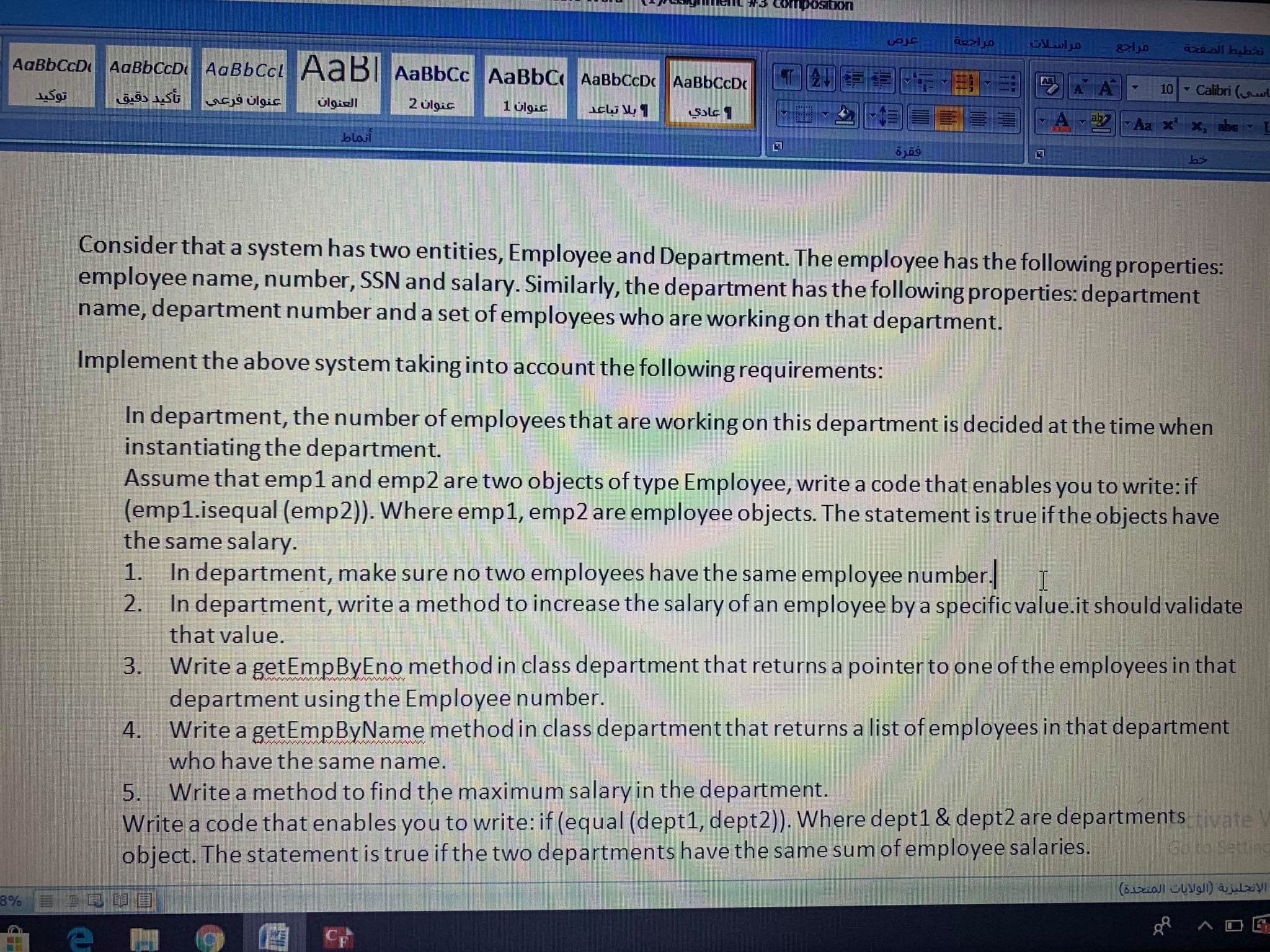Consider that a system has two entities, Employee and Department. The employee has the following properties: employee name, number, SSN and salary. Similarly, the department has the following properties: department name, department number and a set of employees who are working on that department. Implement the above system taking into account the following requirements: In department, the number of employees that are working on this department is decided at the time when instantiating the department. Assume that emp1 and emp2 are two objects of type Employee, write a code that enables you to write: if (emp1.isequal (emp2)). Where emp1, emp2 are employee objects. The statement is true if the objects have the same salary. 1. In department, make sure no two employees have the same employee number. In department, write a method to increase the salary of an employee by a specific value.it should validate that value. 2. Write a getEmpByEno methodin class department that returns a pointer to one of the employees in that department using the Employee number. Write a getEmpByName method in class department that returns a list of employees in that department who have the same name. 3. 4. Write a method to find the maximum salary in the department. Write a code that enables you to write: if (equal (dept1, dept2)). Where dept1 & dept2 are departments tivate object. The statement is true if the two departments have the same sum of employee salaries. 5. Go to Settin
Consider that a system has two entities, Employee and Department. The employee has the following properties: employee name, number, SSN and salary. Similarly, the department has the following properties: department name, department number and a set of employees who are working on that department. Implement the above system taking into account the following requirements: In department, the number of employees that are working on this department is decided at the time when instantiating the department. Assume that emp1 and emp2 are two objects of type Employee, write a code that enables you to write: if (emp1.isequal (emp2)). Where emp1, emp2 are employee objects. The statement is true if the objects have the same salary. 1. In department, make sure no two employees have the same employee number. In department, write a method to increase the salary of an employee by a specific value.it should validate that value. 2. Write a getEmpByEno methodin class department that returns a pointer to one of the employees in that department using the Employee number. Write a getEmpByName method in class department that returns a list of employees in that department who have the same name. 3. 4. Write a method to find the maximum salary in the department. Write a code that enables you to write: if (equal (dept1, dept2)). Where dept1 & dept2 are departments tivate object. The statement is true if the two departments have the same sum of employee salaries. 5. Go to Settin
Computer Networking: A Top-Down Approach (7th Edition)
7th Edition
ISBN:9780133594140
Author:James Kurose, Keith Ross
Publisher:James Kurose, Keith Ross
Chapter1: Computer Networks And The Internet
Section: Chapter Questions
Problem R1RQ: What is the difference between a host and an end system? List several different types of end...
Related questions
Question
write a
note:I want the explanation of the solution step by step

Transcribed Image Text:Consider that a system has two entities, Employee and Department. The employee has the following properties:
employee name, number, SSN and salary. Similarly, the department has the following properties: department
name, department number and a set of employees who are working on that department.
Implement the above system taking into account the following requirements:
In department, the number of employees that are working on this department is decided at the time when
instantiating the department.
Assume that emp1 and emp2 are two objects of type Employee, write a code that enables you to write: if
(emp1.isequal (emp2)). Where emp1, emp2 are employee objects. The statement is true if the objects have
the same salary.
1. In department, make sure no two employees have the same employee number.
In department, write a method to increase the salary of an employee by a specific value.it should validate
that value.
2.
Write a getEmpByEno methodin class department that returns a pointer to one of the employees in that
department using the Employee number.
Write a getEmpByName method in class department that returns a list of employees in that department
who have the same name.
3.
4.
Write a method to find the maximum salary in the department.
Write a code that enables you to write: if (equal (dept1, dept2)). Where dept1 & dept2 are departments tivate
object. The statement is true if the two departments have the same sum of employee salaries.
5.
Go to Settin
Expert Solution
This question has been solved!
Explore an expertly crafted, step-by-step solution for a thorough understanding of key concepts.
Step by step
Solved in 3 steps with 1 images

Recommended textbooks for you

Computer Networking: A Top-Down Approach (7th Edi…
Computer Engineering
ISBN:
9780133594140
Author:
James Kurose, Keith Ross
Publisher:
PEARSON

Computer Organization and Design MIPS Edition, Fi…
Computer Engineering
ISBN:
9780124077263
Author:
David A. Patterson, John L. Hennessy
Publisher:
Elsevier Science

Network+ Guide to Networks (MindTap Course List)
Computer Engineering
ISBN:
9781337569330
Author:
Jill West, Tamara Dean, Jean Andrews
Publisher:
Cengage Learning

Computer Networking: A Top-Down Approach (7th Edi…
Computer Engineering
ISBN:
9780133594140
Author:
James Kurose, Keith Ross
Publisher:
PEARSON

Computer Organization and Design MIPS Edition, Fi…
Computer Engineering
ISBN:
9780124077263
Author:
David A. Patterson, John L. Hennessy
Publisher:
Elsevier Science

Network+ Guide to Networks (MindTap Course List)
Computer Engineering
ISBN:
9781337569330
Author:
Jill West, Tamara Dean, Jean Andrews
Publisher:
Cengage Learning

Concepts of Database Management
Computer Engineering
ISBN:
9781337093422
Author:
Joy L. Starks, Philip J. Pratt, Mary Z. Last
Publisher:
Cengage Learning

Prelude to Programming
Computer Engineering
ISBN:
9780133750423
Author:
VENIT, Stewart
Publisher:
Pearson Education

Sc Business Data Communications and Networking, T…
Computer Engineering
ISBN:
9781119368830
Author:
FITZGERALD
Publisher:
WILEY